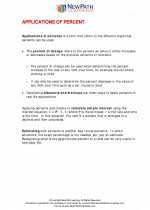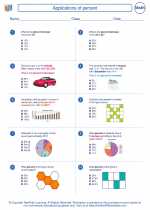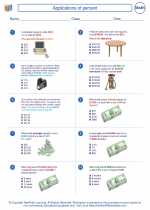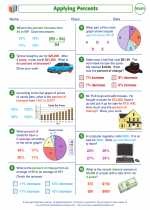Applications of percent -> percent
Percent
Percent means "per hundred" and is used to express a number as a fraction of 100. It is denoted by the symbol "%". For example, 50% means 50 out of 100, or 50/100, which simplifies to 1/2.
Converting between percent, decimals, and fractions
To convert a percent to a decimal, divide by 100. For example, 25% as a decimal is 0.25 (25 ÷ 100 = 0.25).
To convert a decimal to a percent, multiply by 100 and add the "%" symbol. For example, 0.6 as a percent is 60% (0.6 × 100 = 60%).
To convert a fraction to a percent, first convert the fraction to a decimal, then convert the decimal to a percent. For example, the fraction 3/4 is 0.75 as a decimal, which is 75% as a percent.
Finding the percent of a number
To find the percent of a number, multiply the number by the percent written as a decimal. For example, to find 20% of 80, you would calculate 0.20 × 80 = 16.
Increasing and decreasing by a percent
To increase a number by a percent, add the percent of the original number to the original number. For example, to increase 50 by 20%, you would calculate 50 + 0.20 × 50 = 60.To decrease a number by a percent, subtract the percent of the original number from the original number. For example, to decrease 80 by 25%, you would calculate 80 - 0.25 × 80 = 60.
Study Guide
- What is a percent and how is it denoted?
- How do you convert a percent to a decimal and vice versa?
- How do you convert a fraction to a percent?
- How do you find the percent of a number?
- How do you increase a number by a percent?
- How do you decrease a number by a percent?
Practice converting between percents, decimals, and fractions, and solving problems involving finding the percent of a number and increasing or decreasing by a percent to strengthen your understanding of this topic.
[Percent] Related Worksheets and Study Guides:
.◂Math Worksheets and Study Guides Eighth Grade. Applications of percent

 Worksheet/Answer key
Worksheet/Answer key
 Worksheet/Answer key
Worksheet/Answer key
 Worksheet/Answer key
Worksheet/Answer key
 Worksheet/Answer key
Worksheet/Answer key
